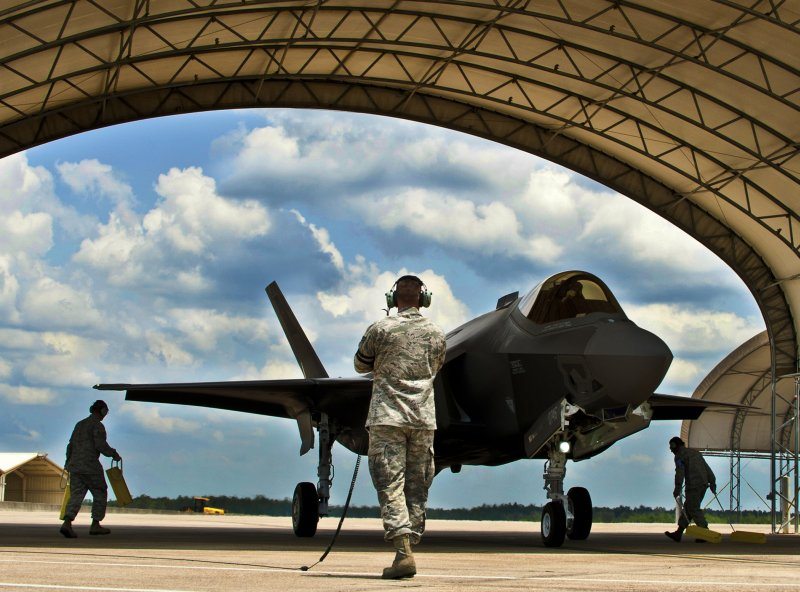POGO has obtained the Pentagon’s latest annual operational test and evaluation report on the F-35 Joint Strike Fighter (JSF), which was not publicly unavailable until now. Bloomberg News’s Tony Capaccio first reported on the report last night.
In the first sentence of the report, the Pentagon’s top tester states that “the high level of concurrency of production, development, and test created several challenges for the program and the Services.” A high level of concurrency means large numbers of aircraft are being bought before the aircraft’s design is mature and well-tested. If serious or significant enough problems are found during testing and development, large numbers of planes may have to undergo expensive retrofits, and adding significant expense to the program. The JSF Concurrency Quick Look Review, which POGO made available last month, recommended a reduction in concurrency.
The test report is authored by the Defense Department’s Director of Operational Test and Evaluation (DOT&E). The DOT&E is Dr. J. Michael Gilmore.
The report details some significant progress in the testing program over last year; however, there is a long way to go in the testing program, with 11,612 test points cumulatively met so far out of an estimated 48,044 remaining. Much of the most difficult testing remains, during which there is a high likelihood deficiencies that will have to remedied—that can increase cost and schedule delays—will be found. For an example of a deficiency identified in testing so far that has to be correctedthe test report notes in its executive summary that:
…live fire tests and analyses showed the fuel tank inerting system is incapable of providing protection from threat-induced fuel tank explosions during some critical segments of combat missions when the aircraft is likely to be hit. The program is redesigning the system. Upon completion, the redesigned system will be evaluated to determine if it provides the required protection.
The JSF section of this year’s DOT&E report is about twice as long as last year’s—13 pages to last year’s 6—which was already longer than most if not all the other individual sections in the annual report. The length is due in part to the three different variants of the JSF: the Air Force’s F-35A conventional take-off and landing (CTOL) version; the Marine Corps’ F-35B short take-off and vertical landing (STOVL) model; and the Navy’s F-35C carrier variant (CV). The F-35B probably has the most problems so far, although the F-35C is at an earlier stage in testing.
One of the main reasons the F-35B has particular difficulties because it has extremely tight weight margins. As of November 2011, according to the report, there are only “230 pounds of margin between the current weight and the intended not-to-exceed weight of 32, 577 pounds.” However, it was recently determined that the not-to-exceed weight can be expanded by 142 pounds. “Managing weight growth with such tight margins for the balance of SDD [System Development and Demonstration] will be a significant challenge,” according to the report.
The program is considering “structural modifications to improve handling characteristics” of the F-35B since they do not meet “current criteria.” The other option being looked at is “relaxation of the handling characteristics criteria.”
In contrast, the F-35A had “acceptable handling characteristics at high and medium altitudes,” however the “magnitude and effects of buffet during elevated g-load and angle-of-attack” will “need to be further examined.” There are plans for more intense flight envelope testing in 2012.
The deficiencies in handling characteristics are a big deal. The JSF is “not on track to meet operational effectiveness or operational suitability requirements,” according to the report, which elaborates that:
The primary operational deficiencies include poor performance in human systems integration (e.g. helmet-mounted display, night vision capability), and aircraft handling characteristics, as well as shortfalls in maneuvering performance (e.g. F-35A combat radius, which is a KPP [Key Performance Parameter], and F-35C acceleration.
The report is very detailed. Here are some of the other things in it that grabbed my attention:
- A large, nearly one-page table details F-35B specific door and propulsion problems with several components of the F-35B requiring redesign.
- Even though they were within stress tolerances, cracks were discovered in F-35B landing gear doors.
- The vertical tail fin of the F-35 may also need to be modified:
- The F-35A flight sciences tested [and] evaluated handling characteristics and performance in a larger, more stressful flight envelope than the other two variants … However, structural loads on the vertical tail fin of the F-35A aircraft…are higher than predicted and may require modifications to the tail or further changes to the flight control software to reduce these effects.
Testers also “found that fuel migrated back into the aircraft” in both the F-35A and F-35B variants. “This has the potential to create an unsafe condition.”
The horizontal tail “sustained heat damage at the inboard trailing edge area” in an F-35A after its afterburner was used for a long time on a flight test mission. “The damage consisted of blistering of the surface and missing pieces of the trailing edge.” Similar damage was found on an F-35B.
[Download not found]









